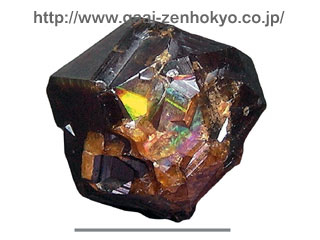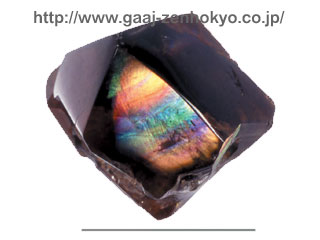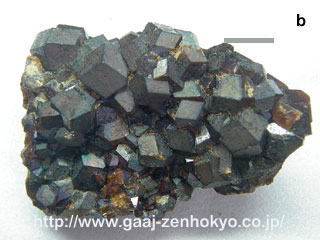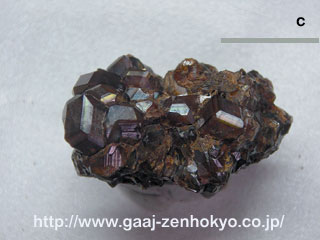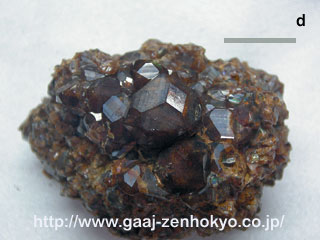|
|||||||||||||||||||||||||||||||||||||||||||||||||||||||||||||||||
| INTRODUCTION @@Garnet is known as a birthstone for January, but it is actually a name for a group of very common rock-forming minerals (basic minerals consisting rocks). Garnet group contains fifteen mineral species, and constituents of six representative species are shown in the table 1. These stones may show broad range of composition with their elements being replaced consecutively (this is called solid solution), for example, grossular and andradite make a series of solid solution (called grandite) between them by continuous replacement of Al with Fe3+. @@Rainbow garnet [fig 1] is a variety of grandite series that sparkles with rainbow colours by iridescence. Its output is very sporadic, and only a few localities were reported in the world so far. The first discovery was made in Adelaide mine, Nevada, USA, in 1934 and research on the cause of its play of colour was carried on, but the material was not in gem quality and did not make a debut in the market. Sonora in Mexico became famous for producing the material for gem market, but its output had been very low from the beginning and the products disappeared soon after circulation in the market for several years in the late 1980s.
There were reports of domestic production of rainbow garnet from Otaki mine in Chichibu, Togane mine in Gifu and Kamihogi area in Yamaguchi, but their output was very small. Recently numerous amount of rainbow garnet was found in Tenkawa village in Nara. The material bears comparison with, or even superior to, that from Mexico which was once circulated in the market. This report introduces microstructure of rainbow garnet from Tenkawa observed by an optic microscope or electron microscope, and discusses the cause of the iridescence. Outline of Locality Tenkawa village in Yoshino county, Nara, is famous for a shrine that is one of three major Japanese Sarasvatis and for a base of pilgrimage route to Omine, where is the centre of Shugen-do (one of religious parties of Japanese Buddhism). Tenkawa has a busiest season in summer with climbers and disciplinants. The gSacred sites and Pilgrimage Routes in the Kii Mountain rangeh containing Omine mountain chain was listed on the World Heritage List in July 2004. Geologically, the strata from the Triassic to the Jurassic Period in Chichibu belt are distributed in northeast of Tenkawa, and the Cretaceous accretionary complexes (Hidaka group) belonging to Shimanto belt are distributed in southwest area of the village. Omine granitic rocks of the Miocene (intermittently) intrude those sedimentary rocks roughly from north to south, and quite a large area has been metamorphosed to skarn or hornfels. Contact metasomatic deposits are also scattered at the contact aureole of the pluton and some mines were once in operation for mining of iron. A group of mineral fanciers was exploring around some mined land in the area and found andradites that were just as iridescent as rainbow garnet several years ago. After that a rainbow garnet vein in superior quality was found in September 2004, whose material was then called gsuper rainbow garneth. (The name was used in the lecture title at the annual meeting of gGemmological Society of Japanh, however, it was pointed out that the name was only for amateur use and not scholarly suitable, so that the prefix gsuperh was removed in this report.) @@The garnet vein was reportedly situated in the middle of a slope, but its outcrop has soon been mined out and what is left now is a pit along the vein with vast amount of rock mound spread down to the bottom of the slope. However, the site had been unceasingly visited by people aiming to collect the material, who occasionally became the trouble with local authority. Signs were built by local police and the village office, and collection of mineral and other substances are now absolutely prohibited [fig 2].
Rainbow Garnet from Tenkawa Village @@The garnet from this village is strongly idiomorphic and most of them are in the form of rhombic dodecahedron with a developed {110} plane [fig 3a]. They are in the size of around several mm to 1 cm, at the maximum 2`3 cm. The colour is from reddish brown to brown and most of them are opaque or with some transparency, but some stones appear opaque dark brown or glittering like metallic [fig 3b]. @@The rainbow colour is often notably seen in the dented area on crystal faces or where striations are developed such as on parting, and some flat crystal face may appear rainbow colour by itself. Crystal face of {110} is predominant comparing to {211}, and many crystals show dodecahedral form closed by {110} face. Also crystals with thinly developed {211} face sometimes occur [fig 3]. These crystals are often translucent, and the {211} face tends to show brighter rainbow colour. Crystal with {211} face dominantly developed than {110} face is seen [fig 3d] with very low frequency. The garnet from this area typically contains cracks(, which can be a flaw in the crystal). Argillization is typically seen between crystals in most of crystal clusters, which are so fragile that they crumble when held by hands.
|
|||||||||||||||||||||||||||||||||||||||||||||||||||||||||||||||||
|
|||||||||||||||||||||||||||||||||||||||||||||||||||||||||||||||||
